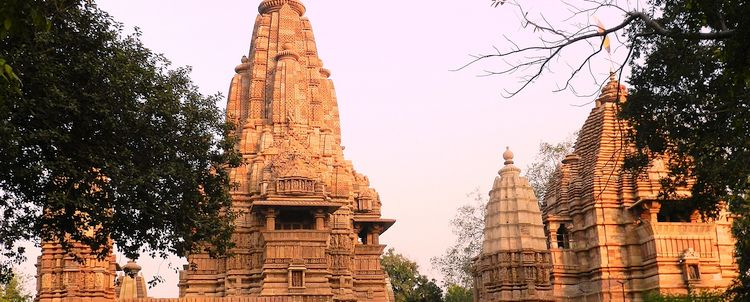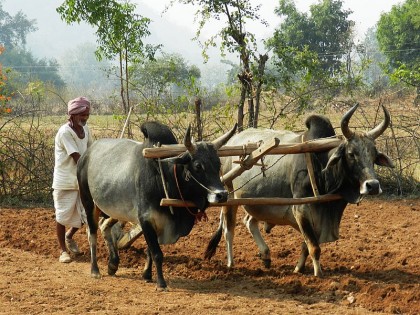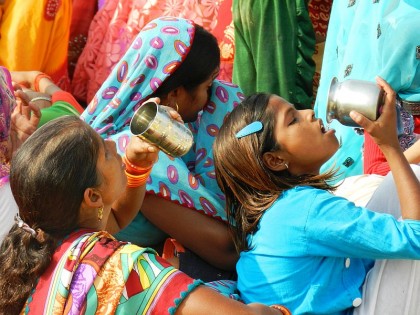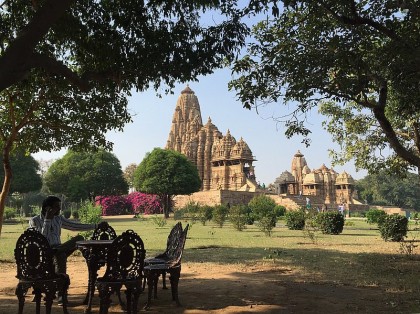





The Heart of India - a Cradle of Humankind
Best Travel Time | Madhya Pradesh in Brief | Peoples and Religions | Food | Flora and Fauna | National Parks and Nature Reserves | History | Economy | Festival Calendar
Not only geographically does the State of Madhya Pradesh really deserve its nickname "the heart of India". If one would like to experience the colorful Hindu culture in all its many facets, and if one wants to stay away from the Golden Triangle, which is heavily frequented by tourists, ones India vacations should tread the bridge to Madhya Pradesh. The state, which is largely situated on a plateau, fascinates with its tropical-subtropical natural variety, and invites to discover the impressive wildlife of the dense jungle in the protected areas (for example in the Bandhavgarh National Park, the Kanha Tiger Reserve or in the Panna National Park).
Unique, rare animals live here, such as the big cat caracal and the gavial, a species of crocodile. But not only flora and fauna impress travelers, especially so are the cultural treasures of the religions and the indigenous peoples, upon some of whom the exclusive award of the UNESCO World Heritage Site has been bestowed. No travel destination worldwide allows travelers to track, based on the most diverse archaeological findings, the comprehensible development of mankind back to Homo Erectus.
The hinduistic cultural development is particularly evident during a visit to the city of temples, Khajuraho, where in the relatively short time span of a century, from 950-1050. B.C., impressive 85 temples were built, which were consecrated to many different gods and have been equipped with an impressively vibrant variety of mural paintings - above all also depicting scenes from the Kama Sutra, 22 of which are still bearing witness to this high period of Hinduism and invite to discover the understanding of joy of those days, of life and of creativity. An equally figurative insight into the culture of Buddhism, especially into the life of the Buddha himself, allows an excursion to the caves of Ajanta, which were declared a UNESCO World Heritage Site in 1983, and which presumably have been expanded and decorated principally in the period between the 2nd and 5th century AD.
Some of the sculptures and frescoes here are older than 2100 years! Many of the Buddhist stupas in Sanchi reach a similar age, some are even said to date from the 3rd century BC. The district bears the title of UNESCO World Heritage Site since 1989, a visit here is enriching, not only for those interested in Buddhism. In the holy city of Ujjain, where there are verifiably settlements since the 8th century BC, Hindu tradition lives in harmony with modernity. Ujjain belongs to the seven sacred sites of Hinduism, and ritual ablutions on the banks of the river Shipra are, not only in the months of April and May during the Kumbh festival, a frequent but always fascinating sight.
Also a visit in Bhopal, the capital of the state, and known as the "city of lakes", completes your impression of Madhya Pradesh and solidifies your personal bridge into the heart of India. The metropolis, which counts today almost 2 million people, lets you immerse yourself into the boisterous, colorful life of modern India, but also offers numerous possibilities to explore the history of the settlement founded in the 11th century BC. As always we are offering you to plan a journey which is completely tailor-made to your interests, and we can offer visits to remote villages and a German-speaking guide in this region.
Best Travel Time for Madhya Pradesh
From October to March the region enjoys a temperate and dry climate: this is the ideal travel time for Madhya Pradesh. From April onwards, the months up to July are then very hot, with daily values above 30°C. The monsoon now moves across the country too; July and August are the months with the highest precipitation, with an average of 11-15 days of rain, and an accordingly high atmospheric humidity. In December and January the temperatures can go back at night down to 10°C, accordingly warm clothing is recommended, if you travel to Madhya Pradesh during this time.
Madhya Pradesh in Brief
| Location | In central India with borders to the state of Gujarat in the west, Rajasthan and Uttar Pradesh in the north and Chhattisgarh as well as Maharashtra in the south. |
| Area | 308.209 km² |
| Population | 72.597.565/ 236 pro km² (2011) |
| Capital | Bhopal |
| Districts | 51 districts in ten divisions: Division Bhopal (Bhopal, Raisen, Rajgarh, Sehore, Vidisha) Division Chambal (Morena, Sheopur, Bhind) Division Gwalior (Ashoknagar, Shivpuri, Datia, Guna, Gwalior) Division Indore (Alirajpur, Barwani, Burhanpur, Dhar, Indore, Jhabua, Khandwa, Kharbone) Division Jabalpur (Balaghat, Chhindwara, Jabalpur. Katni, Mandla, Dindori, Narsinghpur, Seoni) Division Narmadapuram (Betul, Harda, Hoshangabad) Division Rewa (Rewa, Satna, Sidhi, Singrauli) Division Satar (Chhatarpur, Damoh, Panna, Sagar, Tikamgarh) Division Shahdol (Annupur, Shahdol, Umaria) Division Ujjain (Agar Malwa, Dewas, Mandsaur, Neemuch, Ratlam, Shajapur, Ujjain) |
| Topography | Madhya Pradesh is situated at an average altitude of 300-600 meters above sea level. The highest peaks can be found in the Satpura- and the Vindhya mountains, which lie to the south of the state, and lie parallel to each other crossing the country from West to East. The average height of these mountains is 600-900 m above sea level, the highest peak is Dhupgarh with 1350 meters above sea level. |
| Vegetation | Approximately one third of the federal state is covered by tropical forest, especially the eastern, southern and central regions feature rich and largely protected forest areas. Depending on ground composition one can also find teak, sal and sandalwood, many other angiosperms and alaesperms, but also bamboo Dendrocalamus strictus and of course countless other smaller species. |
| Wildlife | In Madhya Pradesh live, mostly in the National Park, cats of prey such as Bengal tigers, leopards and panthers. A wide variety of mammals, especially ungulates such as bovine animals (including gaurs), goats and sheep are there as well. The ornithological diversity will delight bird lovers: countless types of partly rare passerine birds live here, but also exotic species of pigeons, black storks, predatory birds and so on... everywhere one comes across representatives of reptiles, amphibians and insects, and of course - the most beautiful to look at is certainly the wide variety of colorful, tropical butterflies. |
| Climate | Subtropical, continental monsoon climate: the late spring and the summer months are very hot with peak values exceeding 40 ° C. From around July onwards follows the monsoon season with frequent and abundant precipitation and accordingly high atmospheric humidity. From autumn through winter into the spring, the climate has a pleasant temperature and is drier. |
| Temperatures | During the summer months from April to July predominate daytime temperatures averaging 35 ° C, and peak values of more than 40 ° C. From about the end of July, August, during the winter months well into the spring the temperatures are then pleasant between 10 ° C and 20 ° C at night and day values of 25 ° C to 30 ° C. The regional variations are relatively low in Madhya Pradesh. |
| Rainfall | Typically 80% of the total monsoon precipitation rain off in the months of June until mid September. The annual rainfall is altogether on the average slightly more than 1500 mm. |
| Languages | Hindi (88 %), Bhili (5 %), Marathi (2 %), Urdu (2 %), Gondi (1,5 %), Korku (0,5 %), other tribal languages (1 %) |
| Ethnicities | They are predominantly immigrants from surrounding areas. 46 tribal communities account for about 20% of the population, including the largest, the Gond, Bhil, Baiga, Korku, Bhadia, Halba, Kaul, Mariyqa, Malto and Sahariya. |
| Religions | Hinduism (91 %), Islam (6,5 %), Jainism, Christianity, Sikhism, Buddhism and tribal religions (2,5 %) |
| Economy | The population lives mainly from agriculture, cultivated are wheat, soy, chickpeas, sugar cane, rice, corn, cotton, rapeseed, mustard and pulses. Moreover, Madhya Pradesh has a rich deposits of copper ores and also diamond, coal, natural gas, manganese and dolomite, the corresponding processing industry is also located nearby. The most important industry factor is the textile industry, but tourism is also becoming increasingly important. |
| Getting there | |
| Visa / Entry permit | To enter India a passport, valid for at least another six months, and a visa are required. |
| Vaccinations | In addition to the standard vaccinations, immunizations against hepatitis, typhoid, rabies, meningococcal meningitis and Japanese encephalitis are recommended. |
Peoples and Religions
The heart of India is one of the cradles of mankind. "Gondwana", which is widely known beyond its borders and researched manifold, gives us always new archaeological insights to demonstrate the continuous colonization in this region by the Homo Sapiens since the Palaeolithic Age, and allow fascinating glimpses into the lives of our earliest ancestors. However, today the vast majority of the population of Madhya Pradesh does not belong to the tribes originally settled in the region any longer, but is made up of immigrants from the surrounding areas.
Yet there are some districts where the proportion of indigenous people reaches between 30 to over 50% of the total population, and in which an accordingly colorful ethnic mix of religions and traditions prevails. The people of Madhya Pradesh are more than 90% of Hindu faith. Since the caste system, which is common in Hinduism, leads to a splitting of this population group into different communities, an astonishing cultural diversity is also found here, which is also influenced in part by the traditions in the countries of origin of the Hindus. It is noteworthy, that there is a clear economic decline between the "younger" immigrant population and the tribal peoples.
These are more attached to their traditions, and often refuse to adapt their lifestyle to the present time, but due to the distribution of land and take- overs by the immigrants, they see their territories drastically cut, and the farmland at their disposal is often no longer enough for an extensive self- sufficiency. To these people, the slowly increasing, socially and ecologically sustainable tourism gives hope of improving their living conditions in the long run, without needing to give up even more land or to abandon their traditions. In particular, the Gond people, whose tribe populated and controlled the territory of Gondwana up into the Middle Ages, but also the Bhil and the Korku enrich a Madhya Pradesh vacation today through their colorful and diverse celebrations.
Food
Especially in the larger cities and the tourist centers, each Madhya Pradesh traveler can find a wide variety of restaurants and food products, which are adapted to the western palate. The traditional central- respectively South Indian cuisine is widely available, and can be discovered during restaurant visits, in the hotel kitchens and also as a snack at an open food stall in the markets and streets. Widely used are the most diverse curry dishes, but also dhal, the nutritious and diversely flavoured porridge of legumes. For Europeans, it is always very important that one doesn‘t consume unpeeled or uncooked fruits and vegetables to prevent stomach and intestinal complaints.
An indication to the chef regarding the desired degree of spiciness of a meal is often very useful, because chili is a popular and lavishly used spice. Anyone who, stepping over the bridge to Madhya Pradesh, also visits native people’s villages, can of course also get to know the very traditional cuisine. In most cases dishes are very simple, and are made up of ingredients, which are provided by the natural surroundings. Fascinating is the knowledge of the people about the effects and medical properties of the edible parts of plants, which is based on centuries of experience.
Flora and Fauna
The climatic conditions of the state have created in the heart of India a for Europeans exotic animal and plant diversity. Especially in the national parks and protected areas, the biodiversity could be fully retained, and will not only delight nature lovers with its many facets and its beauty. The vast forest areas extend over hills and into permanently humid valleys, consisting often of valuable tree species such as teak, sal Shorea robusta or sandalwood, interrupted by grasslands. They are home to some large predators, including the Bengal tiger, the Indian leopard and the panther.
These large, graceful hunters live a reclusive life right in the thicket of the tropical wet, respectively dry or thorn forests, and are hunting on nearby clearings, where it comes to sightings time and again, for the visitors an unforgettable experience. Other large predators of Madhya Pradesh are sloth bears, wolves and hyenas, but also unique, medium cats like the caracal or civet. Afraid of the hunters are an approximately 50 different species comprising number of cattle-like animals, deer and gazelles and other, smaller mammals such as small bandicoots Bandicota and striped palm squirrel Funambulus.
Common langur and rhesus monkeys inhabit the treetops, filling the air with their cries, apparently in competition with the calls of the birds. The number of birds is clearly fluctuating, due to the immigration and emigration in relation to the respective breeding period, it changes between 300 and 400 species and includes some due to dwindling habitat partly highly endangered specimens. The number of reptiles, which love the subtropical continental climate of Madhya Pradesh, is great. So there are, in addition to various species of snakes like cobras, pythons and vipers, especially diverse species of lizards, even monitor lizards live here.
National Parks and Nature Reserves
In Madhya Pradesh, there are a total of nine national parks and 25 protected areas, which offer a total area of nearly 11,000 km²; a further expansion of these zones is planned. Some of the protected areas are part of the "Project Tiger", whose efforts apply beyond the general protection of the species, also particularly to the highly endangered Bengal tiger Panthera tigris tigris. Due to these efforts, one of the largest tiger populations across India can be found In the Bandhavgarh National Park. In addition, the breeding of leopards has a long tradition, and there are some panthers living in the complex. These big cats are at the top of a food chain comprising 37 different species of mammals.
In the national park lives a wide variety of bovines (like gaurs Bos gaurus as the largest representative, bison, but also muntjak- and sambar deer Rusa unicolor, nilgai antelope Boselaphus tragocamelus, spotted deer Axis axis, and of course several small mammal species feel comfortable in the vast grasslands. On your watch you need to be, in addition of the big cats, of striped hyenas, an Indian subspecies of wolves, canis Lupus indica, and the unique caracal, Caracal caracal, a medium-sized cat species. Travelers who are enthusiastic about birding are looking forward to 250-350 different species of birds - depending on the season - including the up to 1.80 m high sarus crane Grus antigone.
About 80 species of butterflies also inhabit the sky, and compete with various flowering plants about the most brilliant colours. A similar flora and fauna visitors can experience at the Kanha National Park which reaches with its central National Park and the surrounding protection zone a total area of more than 2000 km² and thus represents the largest conservation area of central India. Here one also has the chance of sighting sloth bears Melursus ursinus and barasinghas / swamp deer Rucervus duvauceli or the subspecies of highland barasinghas occurring exclusively here Cervus duvaceli branderi.Even the Panna National Park in northeastern Madhya Pradesh with a central area of over 540 square kilometers belongs to Project Tiger and still received an award in 2007, before in 2009 the extermination of the entire tiger population by poaching had to be accepted.
With a renewed releasing of Tigers was begun immediately, the long-term successes, however, are yet to be seen. Regardless of this, the area was classified in August 2011 as a biosphere reserve in order to conserve the last continuous tropical-subtropical deciduous forest in north of the state after excessive deforestation, to reforest it and to lastingly protect it. In particular, the wealth of primeval teak and unique tree species such as Kardhai anogeissus pendula make the National Park worth seeing and are home to Bengal tigers, leopards, sloth bears, but also spotted deer, nilgai and chinkaras, an Indian gazelle. Populations of the Asian paradise flycatcher, the bar-headed goose Anser indicus, the rose headed parakeet Psittacula roseata, the crested honey buzzard Pernis ptilorhyncus, the red-headed vulture Sarcogyps calvus or its over 200 feathered relatives will certainly persuade birders to visit.
In a separate protection zone here also lives the most critically endangered species of crocodile, the ganges gavials Gavialis gangeticus alongside some other fascinating reptiles. Since the park is located in a part of the Gondwana territory which is populated since prehistoric times, the experience of the pristine nature is supplemented with the discovery of fascinating cultural treasures of human history.
History
In the area of today's state of Madhya Pradesh, a settlement by our ancestors, more precisely by the Homo Erectus, coud be proven already for the geological era of the middle Pleistocene (<180,000 years BC.). Other archaeological finds indicate a continuous settlement of the region since then, with which it must be counted as one of the cradles of humanity. The caves of Bhimbetka near Bhopal, the capital for example, in which a group of homo sapiens already left their mark, are dated to the Palaeolithic period, and with their rock paintings are an archaeological treasure.
In the centuries before Christ, eventually first advanced cultures established themselves, such as the Gond in the kingdom of Gondwana, the Malwa in today's west and south of the state, but also peoples such as the Nanda and the Maurya which, among other things, had to defend themselves against Alexander the Great, but especially had to prevail during power struggles within the region. So throughout the centuries, the ruling dynasties changed from Gupta to Paramara, Gurjar and Gwalior, until finally in the middle of the 19th century the British colonialised the region and ultimately pacified it to a large extent.
With the emerging independence of the young Indian Republic in 1956, the state of Madhya Pradesh was founded from the regions of Madhya Bharat, Vindhya Pradesh and Bhopal, who had split off in the year 2000 the southeastern part of its territory as the most recent alteration, and thus allowing the new establishment of the State of Chhattisgarh. The turbulent history of the Indian heartland impresses even today with fascinating ruins, mighty temples and forts, whose sightseeing should not be missed during a Madhya Pradesh vacation.
Economy
The population of Madhya Pradesh is living from agriculture, mainly wheat, soy, chickpeas, sugar cane, rice, corn, cotton, rapeseed, mustard and legumes are cultivated and exported. The trade in seeds from teak and Sal trees complements fortunately since a few years the excessive felling of forests, and can be cited as another economic mainstay today. Moreover, Madhya Pradesh boasts of rich deposits of copper ores and also diamond, coal, natural gas, manganese and dolomite, the corresponding processing industry is also located in some of the centers.
However, the most important industrial factor are large textile factories, in which artificial silk is produced in addition to the textile processing. The IT industry has settled down in Madhya Pradesh too, especially around the cities of Indore and Gwalior is its importance and the production of entertainment electronics very big. Tourism is increasingly gaining importance in the recent years, and facilitated in recent years a slight economic revival for the tribal peoples who will hopefully lift the state in the foreseeable future off the space as the sixth-poorest Indian state.
Festival Calendar
Also in Madhya Pradesh the dates for festivals and holidays align themselves according to the lunar calendar, so that they take place annually at different calendar dates. Basically, especially the Hindu festivals are celebrated in honor of the gods in Madhya Pradesh, but also regionally unique celebrations provide a wonderful picture of the colourful culture. The most important festival is certainly the Kumbh Mela or Kumbh festival, which is taking place annually, and every six years to a particularly solemn extent in Ujjain, during which the Sadhus, the wise men of the Hindu religion go to perform ritual washing in the months of April and May, ashore the Shipra river, which is celebrated with colorful processions.







